If you are new here, don’t forget to check our Discord Channel. it’s free for everyone!
If you are looking for more Pioneer Creativity content, click here. You’ll find up-to-date sideboard guide with ins, outs and notes about the top fifteen Pioneer matchups.
Introduction
Creativity is a combo-control deck that is built around the card Indomitable Creativity. Your goal is to play it for X equals two, targeting either artifact or creature tokens you produce in early turns. Since there are only two creatures in the deck, you are guaranteed to get the same outcome every single time – Worldspine Wurm combined with Xenagos, God of Revels means that you can present a 30/30 hasty trampler, which is good enough in the vast majority of cases if your opponent doesn’t have proper interaction for the Wurm. The deck can’t win before turn five, so its goldfish isn’t off the charts or anything. On the other hand, as it usually is the case with combo-control archetype, your kill doesn’t require many engine cards, so you can round up your sixty with many different reactive effects to buy time, as well as cantrips to find the missing pieces.
A typical list, by Reid Duke, the winner of Pro Tour Phyrexia:
Why should you play Creativity?
For me, at first, the biggest reason to play the deck was the fact that it’s a good combo deck – I adore this playstyle and if you are a fan of unfair Magic, you’ll fall in love with Creativity. If you’re one of the people clamouring for a Splinter Twin unban in Modern, that’s even better – the gameplay is very similar. Luckily, after a good amount of testing, I found other reasons to keep playing the deck besides my love for combination gaming.
In my opinion, the biggest draw to Creativity is its goldfish potential. Even if the matchup isn’t the best, you’ll always have a chance to draw the proper cheap interaction and finish the game on turn five. This means that Creativity doesn’t have any truly terrible matchups. Sure, there are a few tough ones, especially after sideboarding, but they are not as polarised as you could experience when playing with other Pioneer decks. The deck is also consistent at what it does, so you won’t end up doing nothing and feeling bad about it too often. Another big upside is the capability of winning the game with the generic control plan, especially postboard.
The combo is surprisingly resilient to any generic hate – most creature or artifact removal can be answered by targeting more than two things. This simple trick covers most of the deck’s potential issues and it allows you to save sideboard slots for actual problems. Furthermore, being effectively a one combo instead of an engine deck means that it can pack a lot of interaction in both maindeck and sideboard. All of the above makes Creativity into a flexible deck that can adapt well to nearly anything Pioneer can throw at it.
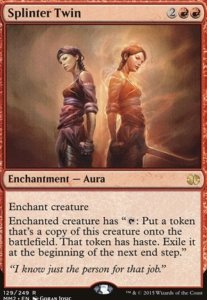
What are the deck’s biggest weaknesses?
Creativity is the deck that wants to have a specific pair of cards in the library at all times to be able to go off. That means that we really don’t want to draw them. While it’s not the end of the world if you draw Xenagos or Worldspine Wurm, and there are ways to put them back into the deck (more on that later), there will be some games you’ll lose because you topdecked either of your payoffs right before you wanted to go for the kill. This will happen from time to time and it can be frustrating, especially for players who are not used to the inherent variance combo decks have.
Another problem is that the deck can be beaten quite easily if someone puts their mind to it. While Worldspine Wurm handles regular creature removal pretty well (thanks to its token making ability), it can be dealt with in many different ways. The most annoying and commonly played one is Otawara, Soaring City – if the opponent can keep open mana at all times, it’s really challenging to win since we can’t counter it. Nearly every blue deck plays at least one copy, so be prepared to lose to it from time to time. But that’s not the only issue – there are other problematic cards to play against: Fading Hope out of Lotus Field is a good example of that. Other cards like Ratchet Bomb, various bounce effects, Aether Gust, etc. can see more play if the deck becomes more popular. Sure, we can have answers for their answers or win games with the control plan postboard, but it’s always easier to end games by attacking for thirty on turn five without much worry.
Mixed gameplans of Creativity
The power of Creativity comes from its flexibility. The combo package takes only a few slots in the maindeck, so there’s room for a lot of other options. This means that the deck can change its playstyle depending on what the opponent is trying to achieve. These are the three most important playstyles Creativity can present:
Pure combo
The easiest playstyle available, and the one that’s used the most. It should be prioritised if our secondary threats match up poorly with what the opponent is doing. For example, a bunch of 2/2s and a 3/3 sharks won’t win the game against Angels, a deck with high-toughness creatures and a great board presence. In that case, going for the hasty Wurm is the only way to win the game. The faster you go for the kill, the better it will be for you. Big Score is your best friend because it’s harder to interact with Treasures than creatures and it gives you more looks for missing pieces.
Combo-control
Some of the enablers are good on their own (I’m looking at you, Fable of the Mirror-Breaker and Shark Typhoon), so it’s possible to win without comboing off, especially with the threat of the instant kill looming over. This can create some ‘false tempo’ situations when the opponent is forced to keep mana open at all times, so they won’t lose to a 30/30 smashing their face. As a result, our otherwise underpowered threats can take over the game and force the opponent to eventually react and tap out to stay alive, leaving themselves vulnerable to our combo. Obviously, this won’t work every time – it all comes down to how well they can handle a bunch of goblins and sharks. This style is most often executed postboard when you trade your otherwise dead removal for more Shark Typhoons and countermagic. When it comes to matchups in which this plan shines, the best example would be 5c Incarnation – they are forced to represent Leyline Binding each turn past a certain point, as well as some extra mana to pay for Make Disappear//Spell Pierce. As a result, they can’t deploy any threats without the worry of being dead to the combo. Usually, the game slows down, which gives you time to either set up a combo with protection or finish the game with secondary threats while disrupting them with countermagic.
HIDDEN COMBO: One thing that often ends the game in this scenario is double Fable of the Mirror-Breaker. Opponents will usually be able to deal with Goblin Shaman tokens, but Reflection of Kiki-Jiki will survive somewhat often. If you have two of them on the battlefield and at least one without summoning sickness, you can use it to copy the other one in the opponent’s end step. This copy will create another one and so on, resulting in you having as many 2/2s as you have mana to spare, which creates a sizable offensive force. This puts a lot of strain on the opponent’s interaction, so even if they’ll be able to stave off this attack, they’ll usually deplete their resources completely, which leaves them dead to the combo.

Heavy control
If your combo matches up poorly against opposing answers, we are forced to change the plan. In game one, it usually comes down to Fables and how much value we can squeeze out of them. But postboard, the dynamic of the deck can change drastically. It can transform into a control deck with only a light touch of combo. Hullbreaker Horror is your best friend here – it’s both a fine target for Creativity (and allows you to cast it with only one target, which is significantly easier to execute than two targets most of the time), and a reasonable finisher to hardcast. Once it’s on the battlefield, you should be able to lock the opponent out of the game by casting cantrips, other cheap spells or even cheap counters and turn them into a wall of bounce spells. This strategy works best when you switch your otherwise dead removal into cheap countermagic, so you’ll make sure to survive until you can land the Horror.
Creativity – analysis card by card
Creativity is a relatively new deck in the scene and we are still far from having a stock list like other top Pioneer archetypes have. Players are debating which warrants are the best and I bet it will take a bunch of time before everyone agrees on how the deck should look like. What makes it even harder (and makes the archetype even more interesting in the process) is that the shell is highly customisable – the only cards you absolutely must have in your deck are 4 Indomitable Creativity, 4 Fable of the Mirror-Breaker, 1 Worldspine Wurm, and 1 Xenagos, God of Revels. While the rest of the deck is usually quite similar as well between different lists, I could see countless situations when toying with the numbers of countermagic, removal or even non-Fable enablers (for example Big Score vs Secrets of the Key) would be reasonable. I’ll try to describe what are the strengths and weaknesses of each card I consider playable, so it will be easier for you to decide what you’ll need for your next Pioneer tournament.
Engine
Indomitable Creativity
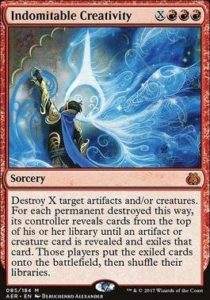
The heart of the deck and the main reason why the archetype exists. The default is to play it with X=2, and that’s what you’ll do most of the time. There are two exceptions though. First of all, you can target more things If you want to play around creature or artifact removal. For instance, if you are worried the opponent has Boseiju, Who Endures and you have a lot of treasures, just target three, or even more of them – even if they destroy one, you’ll get your two creatures anyway. It’s also possible to target opposing threats in addition to your own stuff to deal with them. For example, it’s a good way to answer Thing in the Ice with one counter left on it – otherwise, it’ll most likely bounce the Wurm before it gets a chance to attack. Dealing with large blockers so we can present lethal is another common play.
From time to time, you’ll also be forced to play Creativity with only one target. It won’t be as powerful as your main line, but it has some upsides: it costs virtually two less mana in most cases (one because it only targets one thing, and two because the Treasure it’ll usually target can be used for mana), and it will let you tap out a turn earlier, so you’ll be able to keep mana up for countermagic at all times moving forward – useful in combo matchups, for example vs Lotus Field. The tricky part is that you’ll put only one creature into play this way, which results in two potential outcomes – one is a 15/15 trampler with a relevant ability, and the other one is mostly a blank that will maybe sometimes speed up the clock a bit when attacking with other creatures. I recommend going for this line only if you are sure you’ll find the Worldwpine Wurm. You’ll know it if you:
- Draw Xenagos naturally
- Put Xenagos on the bottom of the library with Fire Prophecy or Valakut Awakening
- Bottom it while resolving Impulse
- Side out Xenagos (rare, but possible)
Another way of making Creativity with one target a good play is to make sure you’ll always find something good. You can achieve it by switching Wurm and Xenagos with something else. Having two Hullbreaker Horrors as wincons instead is a good example.
Worldspine Wurm & Xenagos, God of Revels
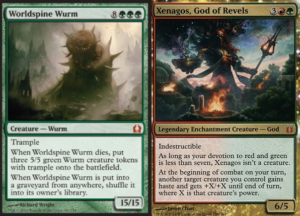
In a perfect scenario, you’ll cast Creativity with two targets, get this duo and attack for thirty damage. Most of the time, it’ll be enough to kill your opponent if the Wurn connects. It’s not Splinter Twin though, and sometimes it may not be sufficient: for example, if the opponent gained a lot of life (Angels), or has more than ten points of toughness ready to block and is threatening lethal on the backswing. Additionally, like most combo kills reliant on a creature, it can also get disrupted with removal. That’s where the Wurm’s triggered ability shines. Getting three 5/5s with Trample will very likely win the game anyway, especially with Xenagos pumping one of them on future turns. Also, remember that Wurm will be shuffled back to the library, so your future Creativity cast will still have a target to find.
Sadly, the world isn’t perfect, so we have to be prepared for all the stuff that can happen. The first, and most annoying one is drawing our creatures. We want them to be in the library, not in our hand. To avoid losing when it happens, the deck has multiple ways to deal with this situation.
Worldspine Wurm in hand:
- Discard it using Big Score or Fable of the Mirror-Breaker. Its replacement effect will shuffle it back into your deck to get later on with Creativity. The opponent can also ‘help’ you by making you discard it with effects like Kroxa, Titan Of Death’s Hunger or Liliana of the Veil.
- Put it to the bottom using Fire Prophecy or Valakut Awakening.
- You can also hardcast it. This sounds crazy, but getting to eleven mana isn’t impossible with how many Treasures the deck can create.
Xenagos, God of Revels in hand:
- Put it to the bottom using Fire Prophecy or Valakut Awakening.
- Hardcast it. Getting to five mana with at least one Treasure producing green is not that hard.
- Just cast Creativity with one target and get Worldspine Wurm in play. Sometimes it will be enough.
The second potential problem is the opponent having tools to deal with our creatures. Xenagos is rarely a problem since it’s an indestructible creature that isn’t a creature (it can become one if you copy Worldspine Wurm using Kiki-Jiki, but it almost never matters). There are some exile and bounce effects that can deal with it though: Masked Vandal or Tear Asunder are good examples. Players usually attack Worldspine Wurm more often. The most common deals of doing so are exile effects, like The Wandering Emperor, Vanishing Verse, etc. and bounce, like Aether Gust, Brazen Borrower, etc. The solution to them is simple – just have countermagic at the ready. You can also sacrifice your Worldspine Wurm in response to the opponent’s answer, so you’ll get three 5/5s in the process – you can do so with Make Disappear. Just target their spell, regardless of whether they have mana to pay for it or not, and sacrifice the Wurm to the Casualty clause. The one card that we can’t do that much about is Otawara, Soaring City. We can’t counter it, and also can’t play narrow answers like Pithing Needle because it interferes with the Creativity combo. This is the one we have to accept will happen from time to time, and adapt when sideboarding. Another line of play is to keep Reflection of the Kiki-Jiki active while going for the combo. If the opponent ever tries to deal with our Wurm, just copy it with the Reflection and you’ll at least get three 5/5s out of it, and sometimes even a free swing with the 15/15.
Enablers
Fable of the Mirror-Breaker
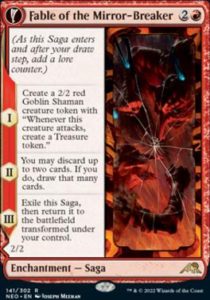
It’s one of the best cards in Pioneer and I bet you already know how strong it is. In Creativity, it’s even better because it serves multiple roles. It’s good in fair games when creating two relevant bodies is good. It’s good at supporting a big combo turn – both because Goblin Shaman can create Treasures we can target later with Creativity and because T3 Fable alone gives you two targets for Creativity X=2 on turn 5, even without attacks. It’s also great at making your gameplan more consistent – looting effects make sure you’ll get land drops early and in later stages of the game it can convert unwanted lands into spells. Finally, if you have two copies on the board, it’s also a ‘hidden combo’ that can steal otherwise lost games (check the ‘Mixed gameplans of Creativity’ section if you don’t know how it works). The card is phenomenal and I would never register a list without a full playset of Fables.
Shark Typhoon
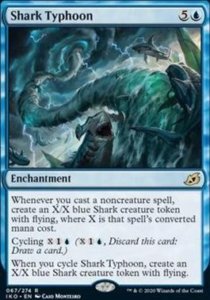
You’ll cycle this card 95% of the time. It’s one of the very few card advantage effects we have in the deck, even if it’s quite mana intensive. It shines in the mid-late game, when a large Shark can dominate the board or at least slow down the opponent’s attacks, so we have more time to topdeck Creativity. It’s an all-star when we need to take a more control route, either using countermagic or creature removal. Good against decks like UW Control, Spirits, RB Midrange, etc. It’s also used as a piece for a surprise turn four Creativity for one – cycle it on their end step to get a 1/1, so you can target it with Creativity.
A somewhat hidden mode of this card, especially if you have mostly Modern experience with it, is to hardcast it. Do it when you know the opponent won’t have any way to deal with it and you’ll be able to survive for long enough to start triggering it. Sometimes it’s relevant, for example, if you can’t win using Creativity due to opposing hate, but one Shark won’t be enough in the long run (for example you play vs GW Company and Elite Spellbinder exiled your Worldspine Wurm from hand).
I like having one or two copies in the maindeck and adding even more after sideboarding when I need it. It’s also possible to side them out if you have better options ready and need to focus on the combo more (for example this scenario happens vs Angels quite often), but the card is so versatile that I tend to keep them in more often than not.
Big Score and Secrets of the Key
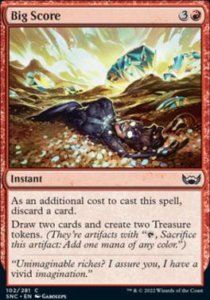
Both cards are very similar to each other in terms of what’s the purpose of having them, overall power level, etc. – that’s why I decided to write about them in the same paragraph.
Before I start talking about nuances, I want to be clear – both Big Score and Secrets of a Key are bad Magic cards. They are in the deck only because producing two targets for Creativity with one card is so valuable. It’s still not decided how many ‘bad’ token makers should be in the deck. The most common setup is copies, usually four Big Scores and one Secrets of the Key, or sometimes one Unexpected Windfall (functionally another Big Score). You can also see versions with just four copies or ones with up to seven, especially when the pilot favours Secrets of the Key and plays a full playset.
There’s still a discussion between the Creativity pilots on which one is better, so instead of convincing you that Big Score is superior to Secrets of the Key (at least in most cases), I’ll write down pros and cons for both cards.
- In the vacuum, Big Score is better because, in addition to creating two game objects for four mana, it lets you draw two fresh cards. Of course, sometimes you have it all in hand already, and the possibility of drawing either of your creatures will turn the draw two into a downside, but in the long run, you’ll more often be happy to dig for something than lose due to a Xenagos or Wurm being drawn.
- The biggest downside of Big Score is its additional casting cost – discarding a card. This makes it bad against countermagic. It can also be a bad topdeck, because without an extra card in hand, you won’t be able to cast it.
- On the other hand, that’s where Secrets of the Key shines. It’s much easier to cast it EOT, either from hand or graveyard. In both scenarios, it being countered isn’t usually a big issue.
- In very long games it will also produce actual card advantage, compared to two for two with Big Score.
- Similarly, casting Secrets from hand and cycling a clue can help you keep making land drops in mid game.
- Secrets of the Key can be discarded to Fable of the Mirror-Breaker or Big Score, so you can create card advantage this way.
- Secrets of a Key is also much better with our secondary threat – Hullbreaker Horror. It’s both a cheap spell that can be cast in early turns, and a one mana spell to trigger the Horror.
- Big Score can discard a Worldspine Wurm to allow you to combo later on.
Overall, in my opinion, Big Score looks better in goldfish scenarios and when Worldspine Wurm + Xenagos finish is good in the metagame. Secrets of the Key looks more powerful in the metagame with countermagic being everywhere and when relying on Hullbreaker Horror is a good thing.
Creature removal
When it comes to removal, Creativity is not well-equipped for extremely long games and taking full control over every possible board you can encounter. Removal is damage-based, so high-toughness creatures are an issue. But that’s not that big of a deal – as long as early removal slows down the pace, our combo will be able to finish the game before opposing big threats take over. So remember – removal’s first and most important task in this deck is to delay the opponent. Sometimes your plan will be to take over with Fable and a pile of removal, or it might even happen randomly in matchups where it’s not usually a viable strategy but don’t expect to win this way against everyone, especially decks with good late game threats like Mono Green or Sheoldred decks.
Fiery Impulse
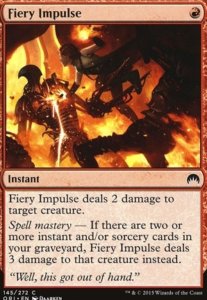
One mana creature removal is necessary and it’s the best one we have access to. It’s worse compared to other UR decks because Creativity doesn’t play cheap cantrips, so it’s harder to enable Spell Mastery. This can have consequences vs x/3 creatures that have to be killed on sight, for example Greasefang, Okiba Boss or Graveyard Trespasser. Still, it’s the best effect we have access to and it will trade up on mana with most two drops and some three drops later in the game too.
Fire Prophecy

Another ‘bad Magic card’ that we kinda have to play. Fire Prophecy isn’t the best on rate, but it’s one of the ways to bottom our creatures we accidentally draw. It can also help us turn lands or extra Big Scores/Creativities into the cards we need more. Remember that it’s a ‘may’ option, so you don’t have to lose life when Sheoldred is on the battlefield for no reason.
Spikefield Hazard
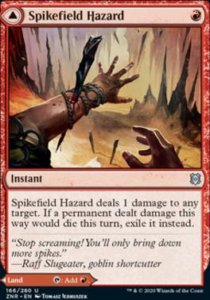
It’s needed mostly to not lose too many games on the draw vs the one drop decks. Exile ability rarely matters, and the only relevant use for it is when you target Cauldron Familiar or Unlucky Witness with it. The biggest strength of it is being a land if you need it, so it’s never truly a dead card.
Countermagic
Similarly to creature removal, countermagic in Creativity is focused more on buying time than locking people out of the game. That’s why I opt for as cheap counterspells as possible, even if that means they will lose their effectiveness later in the game. Your goal is to try and engineer a situation when you cast Creativity on turns 6-8 with countermagic backup – that’s when cards like Spell Pierce or Make Disappear shine.
Make Disappear
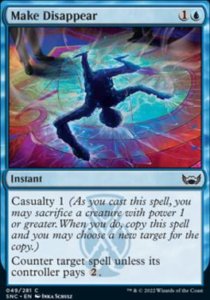
The best catch-all counterspell we can run. In most situations, it will just counter whatever the opponent plays on curve. The more you trade with resources, the more land drops you can play and more likely you are to combo off. Make Disappear is played over Negate or other hard counters because it can find a target in every matchup and it’s very often a trade that’s good for us in terms of tempo. Also, don’t sleep on Casualty 1 – it’s relatively easy to set it up between Shark Typhoon, Fable and Spirits from Sokenzan. In corner cases, you can also animate and sacrifice Mutavault for it. I’ve already mentioned a neat trick you can do with Make Disappear and Worldspine Wurm: you can cast Make Disappear on an exile/bounce effect that’s targeting your 15/15, and then sacrifice it to the Casualty if they have two mana to pay. You’ll still get your statutory three 5/5s and the Wurm will get shuffled back in the deck, ready for another go.
Spell Pierce
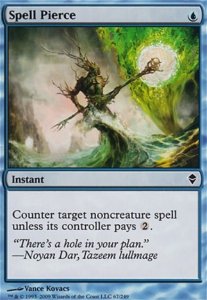
The best spell to protect our combo while not being completely dead in other situations. Spell Pierce gets a nod over Negate in the maindeck as it’s better suited to protect your combo in the mid-game. But I wouldn’t play it, at least not in my starting sixty, if it didn’t have so many good targets outside blue mirrors. Fable of the Mirror-Breaker, Collected Company, Karn, the Great Creator, Esika’s Chariot, Enigmatic Incarnation, and many more – the only matchup when it’s truly dead is vs Humans. That’s why I believe it’s a maindeckable card in most metagames.
Negate
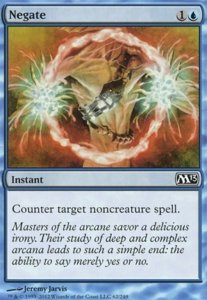
I used to maindeck a couple copies in my early days with Creativity, but now I usually favour Spell Pierce over it for the reasons listed above. I could still see running some if the expected metagame is very controlling and you need to gun for the long game from the beginning of the match.
Card selection
Since Creativity is a combo deck, finding key pieces is important. Pioneer lacks truly powerful cantrips, so we are forced to decide whether we want to favour mana efficiency or maximising the amount of cards seen with our draw spells. The latter is a more enticing option for the deck, hence the inclusion of cards like Impulse over its one mana brethren.
Impulse
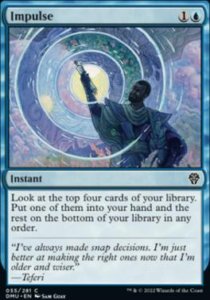
It’s not the best card ever printed, but it does its job well enough to earn a spot in the deck. I side it out quite often when I feel I won’t have time to spend two mana on something that doesn’t affect the board or the stack, but at least it works nicely with all of our instant speed cards. Note that Impulse puts cards to the bottom of the library, so this information can be used in later turns when you want to cast Creativity. For example, if you saw Xenagos among the four cards from Impulse, you’ll be guaranteed to hit Worldspine Wurm from Creativity for one. Bottoming creatures also lets you use cards like Big Score or Valakut Awakening more aggressively without the worry of messing up the combo by drawing either of your creatures. It’s important to note that Impulse works well with Hullbreaker Horror – it’s a cheap spell that you can cast at will to trigger the Kraken.
Dig Through Time
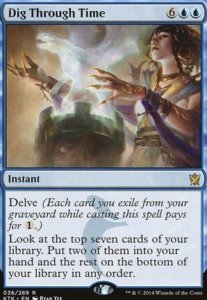
Delve draw spells are crazy powerful, and if you are playing an interactive blue deck, including the first copy is hardly ever a bad idea. However, Creativity is a fairly poor home for Dig, as it lacks the critical mass of cheap spells to enable casting it for two mana consistently. This issue is even more compounded in the face of incidental graveyard hate, like Graveyard Trespasser and Go Blank. Still, playing the first copy is acceptable, but not necessary – Dig Through Time is a luxury card, and not an essential part of the deck by any means.
Valakut Awakening
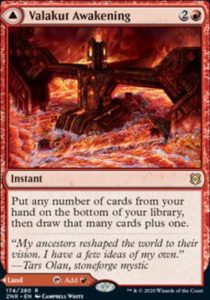
Since we play a lot of lands, having something to trade them for a bunch of fresh cards is a valuable option to have. Valakut Awakening makes sure we won’t have too many copies of the same combo piece too often. It’s also a way to put Xenagos, or Worldspine Wurm back into the deck. On top of that, just like Spikefield Hazard, it’s never truly dead since you can play it as a land.
The manabase
Creativity is a fairly mana intensive deck, as it needs five lands on turn five to combo off, so we can’t afford missing land drops. That’s why the deck plays 27 or 28 lands. It might seem like a lot, especially in a deck full of card selection spells, but you really need to hit all your land drops and the deck has numerous tools to combat the flood, so having such a high land count is rarely an issue. Cards like Fable of the Mirror-Breaker, Big Score, Valakut Awakening and Fire Prophecy will help you get rid of unwanted lands, and a good number of them have other utility beyond simply tapping for mana. In terms of colours, most lands should produce Red since Creativity requires triple red to be cast. Outside of that, the deck isn’t as colour intensive as it may look at the first glance. That’s why it’s possible to run a few non-red lands like Mutavaults or basic Island.
Dual lands
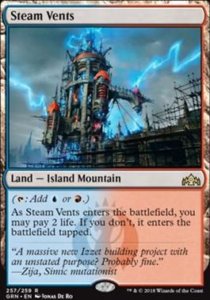
The most important part of the Creativity manabase is UR duals. You need a critical mass of them, so you’ll consistently have triple red for our combo card, as well as blue mana to cast counters and cantrips. The manabase is built in a way to have untapped lands as often as possible, at all stages of the game. To achieve that, the best lands are played as a 4-ofs, while the rest is trimmed and mixed, so you can sequence them right and minimise their drawbacks.
The best ones are Steam Vents and Riverglide Pathway. They always can come into play untapped, help you smooth your mana, etc. Besides that, you have to resort to the aforementioned mixing and matching. Stormcarved Coast is great past turn three, but drawing multiple copies early may affect your development. I like playing four, but I wouldn’t blame anyone for playing fewer copies. Spirebluff Canal, which is a slam dunk 4-of in most Pioneer decks, is significantly worse in Creativity because of how punishing a tap land in the mid game can be for this deck. Not casting Big Score or Creativity on time can be the difference between winning and losing. The last reasonable option available is Shivan Reef. It will always come into play untapped, although it can be painful to use if you don’t draw any other dual and your hand needs a lot of coloured sources. It’s always great to have the first copy, but having three in the opening vs an aggressive deck can be a death sentence.
2 Sokenzan, Crucible of Defiance
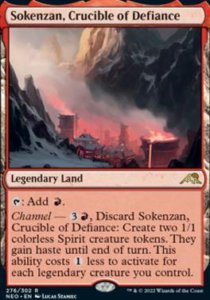
The first copy is basically free, besides some corner cases with Thalia, Heretic Cathar and Field of Ruin, as it’s effectively another Mountain, but with a relevant upside. It can produce two tokens, which conveniently is the number you need to combo off. It also works well when you need to get scrappy and win with a bunch of 1/1s and 2/2s, and can provide a body to sacrifice to Casualty on Make Disappear. Being legendary makes drawing more than one copy somewhat of an issue, but the upside is high enough to justify running two of them.
2-3 Mutavault

Mutavault serves multiple roles in the deck. The main one is to have more targets for Indomitable Creativity, which makes playing around creature or artifact removal easier. For just one more mana, you can get a target that can’t be killed with sorcery speed removal and disenchant effects. I started with only one, but quickly realised how good the card is. On top of being another possible combo piece, it also shines in the midrange/control scenarios – it teams up with Fable and Shark tokens to provide an offensive force, pressures planeswalkers well and can chump block to buy more time. Truly a versatile card and another way to mitigate flooding in longer games.
0-1 Hall of the Storm Giants
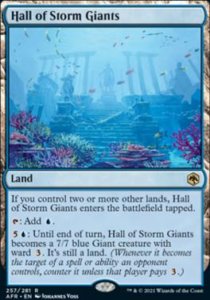
Some people like having one copy to be able to finish the game faster in the late game. Personally, I’m not a fan because it is a tapland more often than not, and would rather play another Mutavault instead. However, if you like having access to a 7/7 beater that’s hard to kill, feel free to play it.
1 Otawara, Soaring City
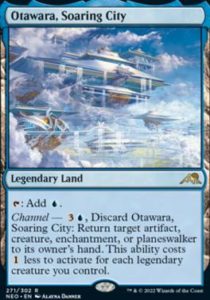
Similar to Sokenzan – it has a very low opportunity cost (the biggest issue is not tapping for red mana) and provides some utility, so including it is usually a good idea.
Basic lands
Basic lands are a safety button against cards like Field of Ruin. You should always play at least one Mountain, just in case. You can also add a second one if you expect to play against these effects more often. Either another Mountain or Island are acceptable in those cases.
Spell lands
As I mentioned earlier, both Valakut Awakening and Spikefield Hazard serve a dual role of boosting your land count and offering an effect that you’re interested in at the same time (turn one removal vs Llanowar Elves and more cantrips to turn lands into spells, respectively). They are also the only lands that can be discarded with the use of Fable or Big Score and fuel Spell Mastery faster. I like the 2/2 split with 28 lands, but if your metagame demands a different configuration, adjust accordingly. Also, if you want to play fewer lands, spell lands are the first ones to cut. In the vacuum, you should cut Valakut Awakening more often, since removal for an early mana elf is usually more important than filtering cards later on.
Sideboard options
With the maindeck being well-equipped to deal with creature and midrange decks, your sideboard’s main purpose is to give you tools to fight vs spell-based decks (both control and combo), and provide with both narrow but powerful removal for certain matchups (mostly Rending Volley) and alternative win conditions (which is Hullbreaker Horror at the moment).
Let’s analyse the most popular sideboard options.
Alternative payoffs
Hullbreaker Horror
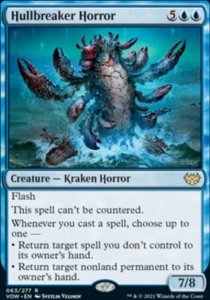
This is probably the most impactful card in the sideboard. It allows us to change the gameplan from combo to heavy control. It can either be put into play via Creativity for only four mana, or simply hardcast, often with the help of Treasures. As it can’t be countered and can protect itself quite well, provided you have mana and spells to trigger it, untapping with it shouldn’t pose much of a problem. Once you do it, it’s really hard to lose since you’ll get access to a powerful control engine – most of the time, the opponent just won’t be able to resolve any relevant spell until the end of the game. It works even better with cantrips when you can chain them and bounce a lot of stuff. While doing that, a 7/8 should finish the game in short order. Eight toughness is important in control matchups, since opposing Hall of the Storm Giants can’t block it effectively.
The biggest question is how often should you change the plan from Wurm + Xenagos to Hullbreaker Horror. Some players opt to go for it relatively often and even rebuild the deck to support the plan even harder (more Secrets of the Key for example), while others use it only if it’s really necessary. Personally, I’m in a second camp – the combo will win instantly in the vast majority of scenarios, while Hullbreaker Horror needs more time and a somewhat stabilised position to take over the game. My rule of thumb is that I side in Horrors only if the opponent has easy access to Otawara, Soaring City (for example Lotus Field), their removal/gameplan matches up perfectly against Wurm (UW Control with countermagic, The Wandering Emperor, and sometimes Soul Partition, or a mirror match postboard when playing around countermagic and setting up Hullbreaker Horror as an ultimate trump is great are good examples), and when it’s really hard to resolve combo pieces and fair plan works well (Mono U Spirits come to mind). Against everything else I tend to keep Wurm + Xenagos, but feel free to try it out in other scenarios too. The whole strength of this strategy comes from a surprise factor – if the opponent doesn’t know it’s coming, it can be better than expected.
Others
It was considered a solution to creature-heavy matchups as a good target for a turn four Creativity. While it has good stats and relevant abilities, I strongly believe that simply comboing off is a better approach.
I was testing Portal when I was searching for an alternative plan vs RB Midrange. It turned out to be a solid card, but it didn’t equate to a win often enough – cards like Sheoldred were painful to play against, as well as corner case plays like the opponent targeting themselves with Go Blank so I couldn’t return anything. Overall, I think that it’s not good enough for the deck.
While Atraxa is a powerful payoff for strategies that try to put a big creature in play ahead of schedule, I don’t believe that it’s exactly what this deck should be looking for. 7/7 with relevant abilities and drawing three or four cards sounds good, but not as good as attacking for thirty. In my opinion, Atraxa will shine in decks that will get it into play on turn three (for example Transmogrify decks with Careful Cultivation and Courier’s Briefcase), not in this version of Creativity.
Removal
Rending Volley
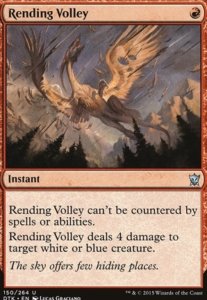
It’s the best red removal spell in the format. It covers a surprisingly large percentage of the format: Humans, Spirits, Angels, UR Phoenix, Greasefang, even Lotus Field (it can kill Lier, Disciple of the Drowned and Vizier of Tumbling Sands). Four damage is also extremely relevant, since many problematic creatures in those matchups have four toughness. For example Adeline, Resplendent Cathar, Bishop of Wings, Righteous Valkyrie, Thing in the Ice, and Ledger Shredder are very hard to deal with unless you have access to Rending Volley. Being uncounterable is a nice bonus. In my opinion, the card is so good and versatile that playing a full playset in the sideboard is almost always reasonable. I would wholeheartedly recommend against going below three copies, at least in the current metagame.
High toughness removal – Fires of Victory, Roast, etc.
I saw some lists playing them as a way to deal with Sheoldred, the Apocalypse. Please don’t do it. Creativity is not the deck that draws a lot of cards, and as a result, it’s hard to deal enough damage with Fires of Victory. As far as other ways to deal with x/5 creatures (for example Roast) go, they are usually too clunky to be good. Make Disappear covers this to some extent, and you can just solve it by bashing your opponent’s head in with a hasty Worldspine Wurm.
Abrade
This is my solution to artifact hate like Ratchet Bomb. If Creativity becomes more popular in the future, having some ways to deal with hate cards will be necessary, and Abrade does it perfectly while being a versatile card that almost always finds some targets.
Mass removal
It’s somewhat tempting to add one or two mass removal spells like Anger of the Gods or Brotherhood’s End. In practice though, the deck has enough removal to slow the opponent down to the point in which the combo or big Sharks will take over the game. The deck just doesn’t need this effect that often – one and two mana removal deal with creatures efficiently enough, so we don’t need more help. Another problem is the presence of x/4 creatures that can survive the sweeper. Because of that, I’m not a fan of having them in the sideboard.
Shark Typhoon
I’ve already written about it earlier, but I feel that an extra explanation of why Shark Typhoon is split between the maindeck and the sideboard is warranted. Additional copies are being added in three situations:
- when the card is just good in a matchup (for example vs Spirits).
- when we side out otherwise dead creature removal for something else and switch the plan to combo-control. Shark Typhoons are our main threats in this strategy since they can be deployed at the end of the opponent’s turn.
- when our gameplan is built around Hullbreaker Horror. Turn three Shark into turn four Creativity is the best goldfish scenario then.
Countermagic
The main purpose of having countermagic in the sideboard of Creativity is to switch removal from the maindeck into something that will be effective vs noncreature strategies – either control (like UW Control, 5c Incarnation, the mirror) or combo (Lotus, to some extent Mono Green). Since you have from six to eight copies of burn spells to take out, you should have a similar number of blue cards ready to replace them. There are many viable options around. They all have their pros and cons, and to minimise the negative aspects of them, the consensus is to play some mix of them, rather than maxing out on some of them at the expense of the others. By doing that, you can for example side in the best four out of eight played in the sideboard in matchups where both removal and counters are necessary (for instance Mono Green). Mixing also lets you adapt better to the changes in the metagame. For example, if you see the rise of green decks, you can go more heavily on Aether Gusts and when blue decks rise, rely more on Mystical Dispute and so on.
Mystical Dispute

It’s sided in only versus other blue decks, but it can serve multiple purposes, depending on the matchup. The main reason is to win counter wars in mid game – cheaper counters means it’s easier to play Creativity and protect it before the opponent has enough lands to keep more mana up. It’s also great at countering blue threats/important engine cards you can face: Teferi, Hero of Dominaria vs UW Control, Pieces of the Puzzle and Treasure Cruise vs Phoenix, Lier, Pore Over the Pages, and Emergent Ultimatum vs Lotus Field, Enigmatic Incarnation vs 5c Fires, etc. It’s also quite good at countering otherwise annoying creatures: Thing in the Ice, Ledger Shredder, and Spirits. I like having two copies in the sideboard, as more of them increases the risk of having too many of them in the late game when the opponent can simply pay three mana.
Negate

It’s one of the most iconic two mana counterspells in Pioneer and a good starting point in a discussion about how good its variations are. It’s good in counter battles, especially in the later stages of the game when soft countermagic loses. It also trades up on mana against most noncreature threats you can see: Teferi and Wandering Emperor vs UW, Karn, the Great Creator and Storm the Festival vs Mono Green, Collected Company and Kayla’s Reconstruction vs Angels, and basically all non-Lier stuff vs Lotus. It’s also an important card to have against Leyline Binding – they tend to keep a lot of mana up, so they can play Binding for one mana and pay for any soft counter you could have – if you respond with Negate, their effort will often be meaningless.
Disdainful Stroke

It’s quite similar to Negate in terms of countering the opponent’s big threats. The tradeoff is between the ability to counter high cmc creatures like Cavalier of Thorns or curve toppers from various Fires decks: Cavaliers, Kenrith, the Returned King, Elesh Norn, Mother of Machines, etc. and not being able to deal with cheaper noncreature threats like Narset, Parter of Veils. Overall, the more I play it, the more I think it’s a worse version of Negate and I tend to favour it over Stroke.
Aether Gust
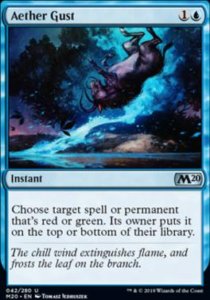
Compared to Negate, the card is much more narrow, and it only delays the threat because the opponent can simply put it at the top and draw it in the next turn. But the upside of being able to affect not only the stack but also the board if you want to is huge. Still, the current metagame isn’t well-suited for Aether Gust. It should be insane vs Green Devotion, but its most scary threat – Karn, the Great Creator – is colourless. It’s good vs RG Boats, but it’s already a good matchup for us. It looks like it could be good in the mirror, but post sideboard the game isn’t centred around Indomitable Creativity, but Hullbreaker Horror, countermagic and Shark tokens. I guess it’s never that bad to not have the first copy in the sideboard, but at the moment, I’m not very high on it.
Narset’s Reversal
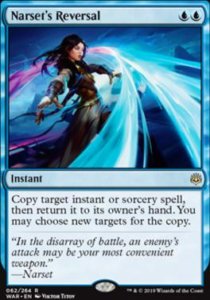
A very interesting card that has many unique uses. Its baseline is to use it in counter battles, so we could either bounce the opponent’s counters or our own spells and replay them later if we want to. Its weird wording lets us ‘counter’ uncounterable effects like Dovin’s Veto. Its other use is to ‘steal’ the opponent’s powerful spells (that usually cost a lot of mana) and gain card advantage this way. Bouncing and copying Delve spells, Pore Over the Pages or Emergent Ultimatum is quite powerful. It’s even better if you target something that can virtually end the game on the spot when resolved – Thought Distortion is a great example. Still, the card is quite narrow and attacks only a small portion of potential problems, so I’m not the biggest fan of it. In my opinion, it’s a similar case to Aether Gust – having one copy in the sideboard will rarely be a bad idea. You can add a second copy if you expect a lot of Lotus Field and Dovin’s Veto.
Other options
Creativity is a flexible deck, and as long as cards you want are not creatures or artifacts (due to how Creativity works), you can freely add them to the sideboard. Most of the potential inclusions fit into one of the above categories, but there’s one card that’s near and dear to my heart that warrants its own group:
Leyline of Sanctity
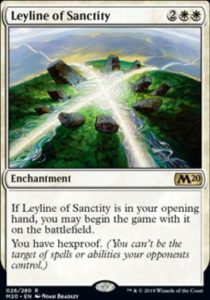
The matchup against discard decks is an uphill battle. I was losing a lot to them and eventually found a solution to it in the form of white Leyline. The card’s purpose is exclusively to help against discard decks – it will never be sided in versus anything else. Nowadays, it means RB Midrange and RB Sacrifice. If you have it, it’s a zero mana counter to every Thoughtseize, Duress, Go Blank and other minor effects. Against Sacrifice, it also stops Mayhem Devil‘s triggers from targeting you. Very often, having it in your opener wins games before they even start. And if you draw it later, you have a lot of ways to loot it away (Big Score, Fable, Fire Prophecy, Valakut Awakening).
Some would say that Leyline of Sanctity doesn’t fit that well to the deck that usually plays a longer game and has a solid, interactive plan B. And I agree – the way of thinking that leads to playing Leyline of Sanctity is closer to a combo player than a control one. Instead of trying to fight an attrition war in which we’re an underdog to begin with, let’s try to protect our main plan. What’s also important here – we don’t have better options against discard. Dig Through Time was my first try, but without cheap cantrips and Trespasser + Go Blank on the other side, I found it hard to resolve. 4 mana draws like Memory Deluge felt way too slow. Leyline was my only solution to the problem and I strongly encourage you to try it if your local metagame is infested with RB decks.
